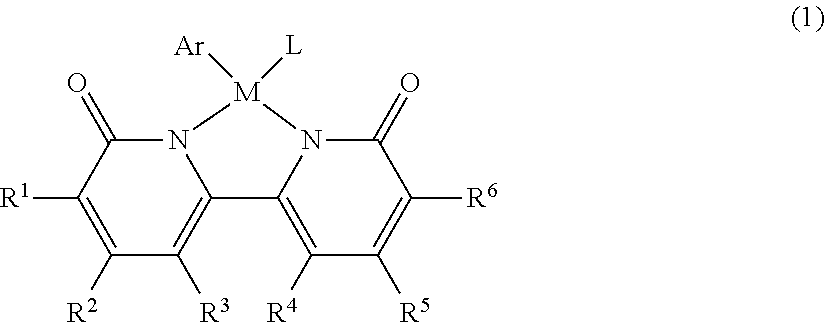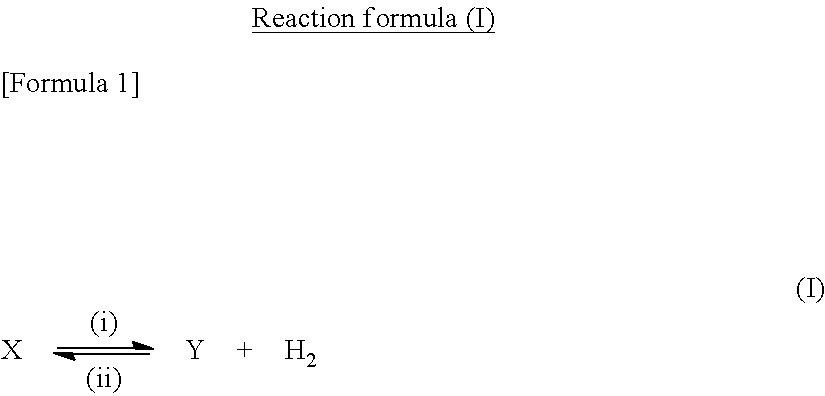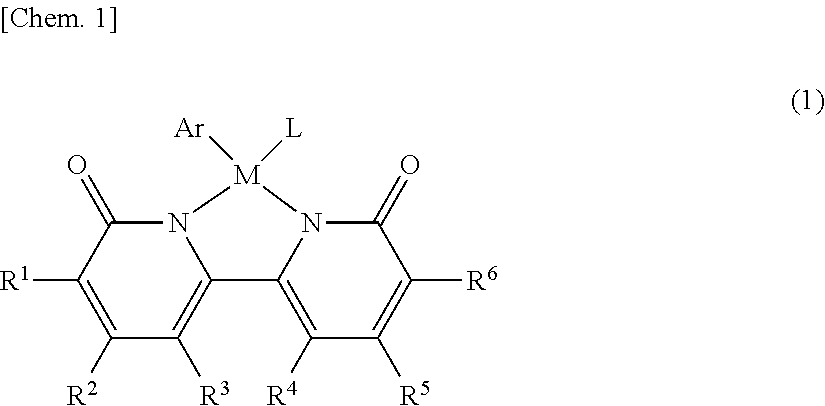Dehydrogenation catalyst, and carbonyl compound and hydrogen production method using said catalyst
a carbonyl compound and catalyst technology, applied in the direction of catalytic reactions, liquid gas reaction processes, energy inputs, etc., can solve the problems of large amount of catalyst, difficult industrial use of oxidizing agents and oxidation methods, and large substrates to which it can be applied, etc., to achieve easy dissolution of substrates, high yield, and high solubility
- Summary
- Abstract
- Description
- Claims
- Application Information
AI Technical Summary
Benefits of technology
Problems solved by technology
Method used
Image
Examples
production example 1
[0120]Neutral iridium complex 1 was produced by the method shown in either production example 1-a or 1-b.
production example 1-a
[0121]As shown in synthetic scheme 1-a, a dicationic Cp* iridium-aquo complex (407.8 mg, 0.60 mmol) was reacted with 6,6′-dihydroxy-2,2′-bipyridine ligand (113.8 mg, 0.60 mmol) in aqueous solvent (12 mL) to thus give complex A (yield 93%). Subsequently, complex A (915.0 mg, 1.1 mmol) was reacted with sodium t-butoxide (211.4 mg, 2.2 mmol) in aqueous solvent (30 mL) to give neutral iridium complex 1 (yield 84%).
production example 1-b
[0122]As shown in scheme 1-b, [Cp*IrCl2]2 (458.4 mg, 0.570 mmol) was reacted with 6,6′-dihydroxy-2,2′-bipyridine ligand (250.0 mg, 1.33 mmol) in methanol solvent (8 mL), a reaction was carried out at 60° C. for 3 hours, and filtration using a glass filter was then carried out to thus give cationic complex A′ (yield 74%). Subsequently, cationic complex A′ (100.0 mg, 0.170 mmol) was reacted with potassium t-butoxide (38.3 mg, 0.340 mmol) in water (5 mL) at room temperature for 30 minutes while stirring, and a solid thus precipitated was filtered to thus give complex 1 (yield 64%).
[0123]1H NMR (400 MHz, CD3OD) δ 7.43 (t, J=8 Hz, 2H), 6.92 (d, J=8 Hz, 2H), 6.43 (d, J=8 Hz, 2H), 1.59 (s, 15H). 13C{1H} NMR (125.8 MHz, CD3OD) δ 170.9, 157.3, 139.9, 118.1, 106.9, 88.0, 9.83. Anal. Calcd for C20H23O3N2Ir: C, 45.18; H, 4.36; N, 5.27. Found: C, 45.47; H, 4.01; N, 5.62.
PUM
| Property | Measurement | Unit |
|---|---|---|
| Efficiency | aaaaa | aaaaa |
Abstract
Description
Claims
Application Information
 Login to View More
Login to View More - R&D
- Intellectual Property
- Life Sciences
- Materials
- Tech Scout
- Unparalleled Data Quality
- Higher Quality Content
- 60% Fewer Hallucinations
Browse by: Latest US Patents, China's latest patents, Technical Efficacy Thesaurus, Application Domain, Technology Topic, Popular Technical Reports.
© 2025 PatSnap. All rights reserved.Legal|Privacy policy|Modern Slavery Act Transparency Statement|Sitemap|About US| Contact US: help@patsnap.com



